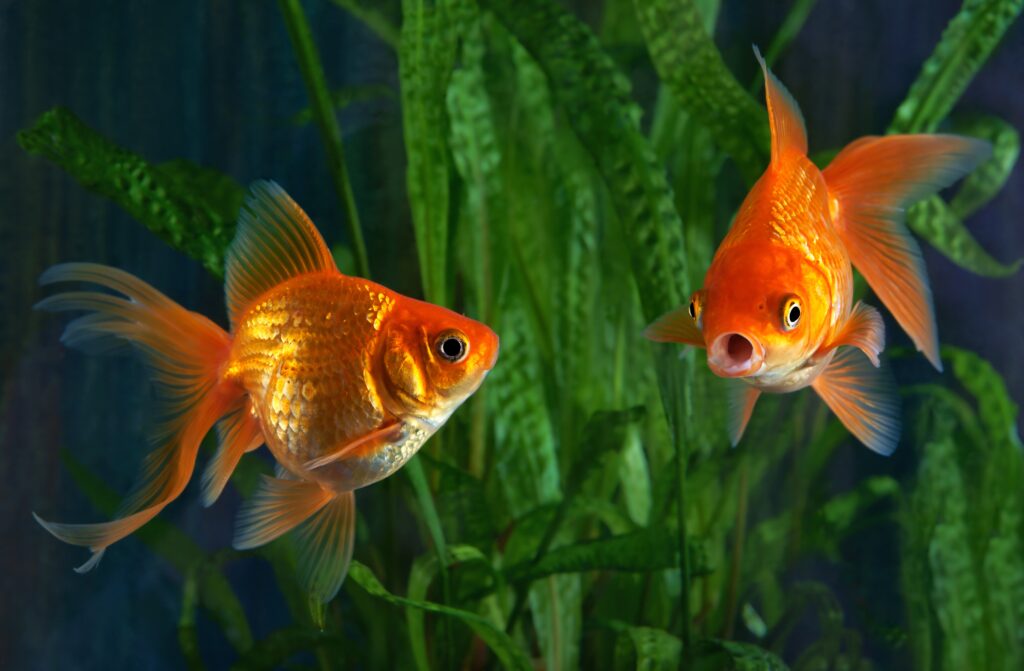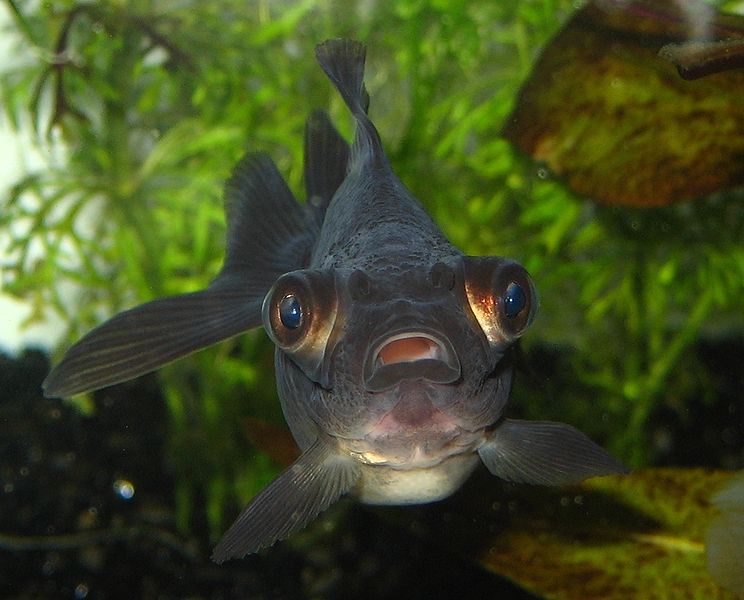In imperial China during the Jin Dynasty (266 – 420), the ancient gray or silver colored Asian Carp was first recorded to have produced red, orange and yellow color variations.

Then during the Tang Dynasty (AD 618 – 907), it became a trend to raise these carps in what we would refer to in the modern day aquarium hobby koi ponds. These outdoor pond environments are typically shallow, which allows the Asian carp to get plenty of sunlight. This resulted in a natural evolution and genetic mutation which produced a yellowish/orange or “gold” color. From there, the selective breeding practice of this fish was born.
During the Song Dynasty (AD 960 – 1279), the selective breeding of the current day Goldfish species began. In 1162 the empress of the Song Dynasty, Empress Wu, ordered the construction of the first collection pond. The goal of this pond was to collect the red and gold variety of the Goldfish. During this time, people who were not in the imperial family were forbidden to keep yellow/gold colored Goldfish. This was due to an attempt by the imperial family to keep this color exclusive as they dubbed this color variation the “imperial color”.
Goldfish began to be raised indoors during the Ming Dynasty (1368 – 1644). This allowed for the selective breeding for mutations that would not be able to survive in the outdoor ponds. The first occurrence of the commonly known Fancy-Tailed Goldfish was recorded during this period.

In 1603 the Goldfish was introduced to Japan and then Portugal in 1611. From there, it was introduced to other parts of Europe. During the 1620s, southern Europe grew very fond of the species due to their metallic looking scales. This species quickly became a symbol of good luck and good fortune. In 1850 the Goldfish was introduced to North America and quickly became a very popular fish in the United States.
Now that we have the background on how this species became one of the most popular aquarium fish of all time, let’s take a look at 11 unbelievable facts about them.
1. How to Tell a Goldfish’s Age
Every year the Goldfish develops a ring on it’s scales called a circuli. Under a microscope you can see the circuli and you will notice from the picture below that they resemble the rings of a tree trunk – which also tells you the age of the tree.
The circuli are made up of bones and scales that grow together in thin layers. In the summer fish tend to grow faster which results in larger and wider apart circuli that also appear lighter in color. By counting the summer or winter layers, you can determine the age of the Goldfish.
2. Goldfish Have Very Unique Eyesight
The human eye can see three primary colors at once: red, blue and yellow. All of the other colors that we see are a mixture of those 3 colors. A Goldfish on the other hand can see four primary colors. They see red, green, blue and ultraviolet. This puts the Goldfish in the tetrachromat classification.
Tetrachromacy means that the species’ retina contains four types of higher intensity light receptors – 4 cone cells instead of 3 like we have. Any organism with this ability is referred to as a tetrachromat. Several species of birds, fish, amphibians, reptiles, insects and even some mammals are tetrachromats like the Goldfish. This allows them to spot prey much easier by being able to see the difference in coloration between their habitat and their prey.
3. Goldfish DO Have A Memory
In 2006, Eric R. Kandel, M.D. a University Professor and Kavli Professor of Brain Science in Neuroscience at Columbia University, shared the Nobel Prize in Physiology and Medicine for his work which explains the neurobiology of memory. His work is known as the “In Search of Memory” guide which is comprised of 30 chapters. It guides the reader through Kandel’s life, discoveries and explains that the hippocampus is part of the cortex of the brain that stores memory. Goldfish do not have a cortex nor a hippocampus. This discovery led scientists to further experiment and research whether or not the Goldfish has a memory.
Also in 2006, scientists discovered that fish use spatial cognition and that they rely on allocentric cues in order to navigate. They also discovered that there are areas of the fish brain that are comparable to the hippocampus that humans have. In 1996 it was documented during a training session with Goldfish that they can switch from allocentric to egocentric cues. Egocentric cues are based on direction (left/right) responses and actions which are independent of environmental cues. These experiments concluded that the Goldfish does in fact have the ability to convert short-term memory into long-term memory. This was determined by having the Goldfish find their way out of a maze. The experiment proved that they do in fact have a memory and that it is definitely longer than a couple of seconds – which was previously believed to be the duration.
Watch this Goldfish memory experiment conducted by YouTuber Tiesja Huscroft utilizing water bridges:
For an additional experiment, check out this one by YouTuber Fish For Thought:
4. Goldfish Can be Trained
As you can see from the above 2 videos – yes, Goldfish can be trained. To what extent can they be trained? Watch the ultimate Goldfish training video – the Goldfish playing soccer video to find out:
5. What Makes a Goldfish Get That Bright Orange Color?
The Goldfish has clear scales over their skin. Yes – you read that correctly – their skin has certain coloration or pigments to it that is enhanced by sunlight or a source of UVA and UVB light. Their skin coloration is produced by three color pigments:
- Erythrin (Red)
- Melanin (Black)
- Xanthin (Yellow)
All three of these pigments are contained within cells called chromatophores. Within the chromatophores are iridocytes. These are specialized cells that act as multilayer nano-reflectors. All of the different coloration variations are a mixture of these cells and pigments.

So what factors determine the coloration of a Goldfish?
- The position of the chromatophores which can be positioned on the surface of the skin (above the scales), immediately under the scales or deep in the skin.
- If the chromataphores are very dense, the coloration of the Goldfish will also appear dense. If the chromataphores on the surface of the skin are very dense, it will block the chromataphores below.
- In addition to the density of the color, the stability (or lack of fading) of the colors is affected by the position of the chromataphores. For example, the chromataphores on the surface of the skin will often produce unstable coloration due to them being removed or spreading as the fish ages. The chromataphores deep in the skin are more stable and less likely to break up. The ideal situation for color stability, is to have the same dense color pigment in all layers of the skin. This results in both a dense and stable color for the Goldfish.
6. What is the Lifespan of Goldfish?
The oldest Goldfish ever recorded was ~43 years old.
His name was Tish and he was won at a funfair by a family that resided in the UK. Tish was recognized by the Guinness Book of World Records as the longest living fish.
7. How Big is the Largest Goldfish?
The Guinness record for the world’s longest goldfish stands at 18.7 inches from nose to tail.
8. How Does a Goldfish Eat?
The Goldfish does not have a stomach. Instead, it’s intestines have different parts that aid in the digestion of food. Their intestinal tract is approximately twice the length of their entire body. They also do not have teeth in their mouths – they have them in the back of their throat. Their teeth are called pharyngeal and they are flat. Another interesting fact about the mouth of the Goldfish is that their taste buds are located on their lips – since they do not have a tongue.
When a Goldfish gets a piece of food in their mouth, they chew it up in the back of their throat and then the food goes into their intestines. As it makes its way through, it gets broken down and then exits the fish. This is why the Goldfish needs to eat small amounts of food several times per day so that it does not overwhelm it’s digestive system. Overfeeding can foul the water in their aquarium and create a major health issue for them. This is why it is important to feed them small amounts throughout the day.
9. How Many Eggs Can a Female Goldfish Lay?
During a single spawning session, a female goldfish can lay over 1,000 eggs at a time. Once they are fertilized it will take on average about 4 days for them to hatch. However, not all of them will hatch, only very few, approximately 30%.
When raised properly they grow fairly quickly. YouTuber Lifewithpets shows the growth over a 4 week period.
10. Goldfish Need a Proper Aquarium Setup in Order to Live Long, Health Lives
It was believed for quite awhile that Goldfish can survive in a bowl without filtration. This is not true at all. Goldfish need to eat small amounts of food frequently since their digestive system is unique and works fairly quickly. Because of this, uneaten food and waste can create a water quality issue without proper filtration.
In the following video, YouTuber Jennifer Lynx goes into great detail about the proper Goldfish habitat set up.
11. Goldfish Once Invaded and Overtook an Entire Lake in Denver Colorado
In 2015 a handful of Goldfish were put into a lake allegedly by a pet owner (something that should never be done). They absolutely thrived in the lake and eventually overran it, decimating the indigenous species who called the lake home. It was estimated that ~3,000 to 4,000 Goldfish were inhabiting the lake during that time.
In 2012 a method called electrofishing was deployed in order to help wildlife officials remove ~2,300 Goldfish from the lake. Electrofishing entails placing a live wire from a boat into the water. An electric current is then emitted by a device to the live wire and temporally stuns the Goldfish. This forces them to the surface where they can be netted alive. They can then be relocated from there. In this particular case, local herons are said to be the heroes as they ate all of them out of the lake which ultimately solved the problem.
